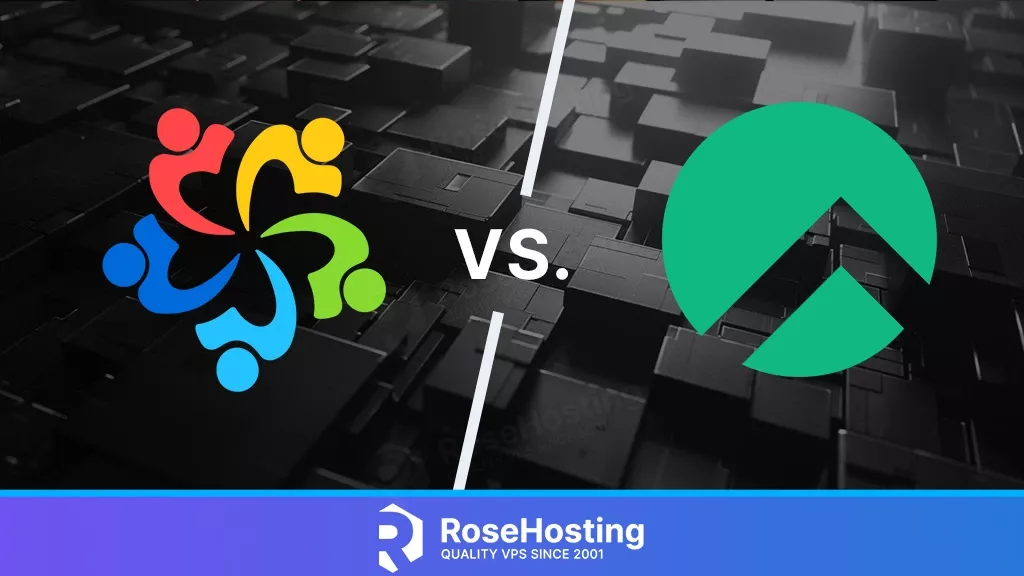
Are you in the process of selecting an enterprise Linux distribution and find yourself comparing AlmaLinux vs. Rocky Linux? You’re not alone. These two open-source, community-led contenders are the top CentOS replacements, each offering a reliable enterprise solution. Both AlmaLinux and Rocky Linux were born in 2021 due to the discontinuation of CentOS by Red Hat. These distros offer a 1:1 compatibility with Red Hat Enterprise Linux (RHEL). This makes the AlmaLinux vs Rocky Linux comparison a hot topic for developers and sysadmins alike.
AlmaLinux, backed by CloudLinux with a $1M annual development fund, quickly gained traction with its robust security configurations. Rocky Linux was sponsored by CIQ securing $26M in funds. They opted to integrate SELinux for rigorous access control. While similar in performance and stability, these CentOS alternatives differ subtly in aspects like security features and community scale—AlmaLinux with notable partners including Microsoft and AWS, and Rocky Linux with support from giants like Google and VMware.
Next, we’ll be exploring the key features each has to offer, benchmark performance and stability, delve into their unique security capabilities, and weigh the level of community support and development — all crucial factors to help you decide between Rocky Linux vs AlmaLinux as your preferred CentOS replacement.
Table of Contents
Key Features and Compatibility
As you compare between these OSes, you’ll find that AlmaLinux and Rocky Linux have established themselves as the go-to options for those seeking CentOS alternatives. Both enterprise-grade operating systems have been designed for stability. Each are renowned for their RHEL compatibility. Despite that, they differ in how they’ve been developed and the unique features they offer.
AlmaLinux Features
AlmaLinux, which saw its inception under the guidance of the CloudLinux OS team, pledges its compatibility with an initiative to mirror RHEL closely. Its development is bolstered by a substantial annual $1M sponsorship, including funds from CloudLinux and other contributing organizations. Among its key features, you will find:
- 1:1 binary compatibility with RHEL, assuring you of seamless migrations and robust integrations.
- A commitment to system security, incorporating the CIS Benchmark for hardened system configurations.
- A forward-looking 10-year lifecycle and an 8-year support horizon, ensuring long-term stability for your enterprise.
Rocky Linux Features
This brings us to Rocky Linux, spearheaded by Gregory Kurtzer, a creator of CentOS. You’ll notice a focus on painstaking compatibility with RHEL. With a hefty $26M in funding by CIQ, Rocky Linux positions itself as a dependable choice for enterprise users. Its highlighted features include:
- 100% bug-for-bug compatibility with RHEL, ensuring your systems operate with assurances of consistency.
- Adoption of the Network Time Security (NTS) protocol within NTP, reinforcing the timing-related security of your servers.
- Secure Boot support, offering enhanced protection during the system boot process against a range of security threats.
When it comes to architecture support, both AlmaLinux and Rocky Linux support the widely used x86_64 architecture. Other supported architectures include PowerPC, ARM, and IBM’s Z architecture. This maintains parity with RHEL to facilitate a smooth transition for users. Both offer great architecture support regardless of whether you use x86 or ARM processors at your hosting provider’s data center.
Additionally, they both include a great lifecycle and support timeline. Both promise regular updates closely following RHEL releases, often within a business day. This gives you assurance that your systems are not just secure, but also equipped with the latest in enterprise Linux advancements.
Our personal experience with compatibility is that more software out there supports AlmaLinux compared to Rocky Linux. Odds are you can run some of that software on Rocky Linux just fine. However, some of it may not work right and no matter what you’ll have nobody to turn to if something doesn’t work.
Performance and Stability

Performance and stability are crucial for any enterprise Linux environment. Thanks to AlmaLinux and Rocky Linux’s shared heritage as CentOS replacements, both distributions promise exceptional reliability as they inherit the mature and stable base of RHEL. With a guaranteed 10-year lifecycle, you’re looking at long-term support which is critical for business applications.
Regarding performance, AlmaLinux and Rocky Linux offer remarkable reliability, vital for systems where downtime can lead to significant business losses. You’ll find regular updates for both, with a delay of at most one business day from RHEL patches. This ensures your systems are current and secure. Let’s break down their performance criteria:
- Update Frequency: With updates rolling out within one day of RHEL releases, you stay on top of the latest features and security updates.
- Resource Efficiency: Both distributions are optimized for minimal overhead, ensuring your hardware can run demanding applications without a hitch.
While you investigate Rocky Linux vs AlmaLinux, remember that stability isn’t just about system crashes or bugs. Stability is also about the dependability of a distribution’s lifecycle. Both contenders align with enterprise Linux expectations, offering a decade of support that provides peace of mind for long-term planning and investing. Considering these aspects, whether you lean towards AlmaLinux or Rocky Linux, your enterprise will benefit from a stable and performance-optimized OS, filling the void left by CentOS.
Security Features
As you weigh your options between AlmaLinux vs Rocky Linux, security features are sure to be at the forefront of your decision-making process. It’s crucial to protect your server environments. Both distributions come robustly designed with security in mind. Here’s how they stand up against each other in terms of security.
AlmaLinux
AlmaLinux has an edge with security thanks to its integration of the CIS Benchmark. This is a set of best practices for securing IT systems and data against cyberattacks. You’ll find that AlmaLinux not only offers a support lifecycle of 10 years, but it also comes equipped with tools like CIS-CAT to help you identify and rectify potential security issues, giving you an added layer of confidence in your system’s integrity. Moreover, AlmaLinux keeps you updated via:
- Errata and OpenSCAP for timely security advisories
- OVAL definitions to check for the presence of vulnerabilities
- Security Mailing Lists, ensuring that you’re always informed about the latest security patches and updates.
Rocky Linux
On the flip side, Rocky Linux secures its place as a secure CentOS replacement with SELinux (Security-Enhanced Linux), a Mandatory Access Control system created by the NSA. If your organization needs granular control through security policies, Rocky Linux is designed to provide that, with SELinux being a core feature within its ecosystem. Not to be outdone in terms of support, Rocky Linux ushers in a commitment to long-term stability, offering:
- Network Time Security protocols for safer NTP operations
- Consistent long-term support for their releases and bug fixes to ensure ongoing system optimization and secure operation.
Selecting between AlmaLinux and Rocky Linux may hinge on your specific security requirements. Both distros are production-grade CentOS alternatives that take security seriously. Your choice may be influenced by points like the implementation of the CIS Benchmark in AlmaLinux 8.4 and newer, or the added control over system access that Rocky Linux and SELinux offers.
Overall, we recommend AlmaLinux for its excellent all-round security features. It offers almost everything that Rocky Linux offers, and then some.
Community Support and Development

Community support and development are vital for the longevity and reliability of any enterprise Linux distribution. As you compare AlmaLinux vs. Rocky Linux, you should look into the community support behind these CentOS alternatives.
First and foremost, you’ll be pleased to find that both AlmaLinux and Rocky Linux are backed by strong, community-driven support systems. Following CentOS’s discontinuation, these distributions filled the void, rapidly accumulating developers, users, and enthusiasts dedicated to their prowess and stability. In fact, the growing number of partners and sponsors for both has been very impressive. Let’s consider some key points about their community beliefs:
- AlmaLinux benefits from the support of CloudLinux Inc., which brings substantial funding to the table. This not only provides a stable financial foundation but also signals strong enterprise viability with backing from a reputable company in the Linux space.
- Rocky Linux, with the significant funding of $26 million by CIQ, has shown similar strides in community growth. This kind of support is a testament to its potential and a clear indication that Rocky Linux is here for the long haul.
Community Key Points
- Build Systems: AlmaLinux uses the AlmaLinux Build System (ALBS) to create its assets, displaying a tailor-made approach for their repositories, while Rocky Linux opts for Koji and Peridot, known for their reliability and scalability.
- Community Mirrors: With a significant number of global mirrors, 302 for AlmaLinux and 165 for Rocky Linux, access to software packages and updates is broad and readily available. This enhances the user experience for individuals and enterprises worldwide.
- Migration Tooling: Both distributions provide specialized tooling to facilitate an easy transition from other operating systems. This not only shows their commitment to the platforms, but also makes your life easier.
This collaborative environment is not just about feature development. It’s about creating a platform where users and developers combine to share knowledge, troubleshoot issues, and collectively enhance the OS.
Whether it’s AlmaLinux or Rocky Linux, each offers a strong background of members that believe in their operating system. Ultimately, using managed support for your server is the best way to protect your business. Our Fully-Managed AlmaLinux hosting gives you the confidence you need to focus on your business. Our team is here 24×7 to manage all aspects of your server, including the operating system as well as all software you or we install onto it. This is a level of support that no other managed hosting provider even comes close to offering.
Conclusion
We believe that both AlmaLinux and Rocky Linux offer a pretty well-rounded experience for business use. They each offer great compatibility with RHEL and CentOS applications. They both have a large community following. Both give you 10 years of software updates.
Our personal recommendation goes to AlmaLinux, as we believe it has a more complete solution compared to Rocky Linux. AlmaLinux also has a larger community following and has more custom-made software. Also, more software solutions directly support AlmaLinux compared to Rocky Linux.
That doesn’t mean that Rocky Linux won’t work for you – it probably would. We just found in our personal experience that AlmaLinux works better most of the time.
FAQ
Here are some frequently asked questions (FAQs) which may help you decide whether to go with AlmaLinux or Rocky Linux:
- Which should I choose between AlmaLinux and Rocky Linux for my enterprise needs? Selecting between AlmaLinux and Rocky Linux for your enterprise depends on your specific requirements and preferences. Both distributions offer RHEL compatibility and are open-source, making them viable CentOS alternatives. AlmaLinux has a broader software support, which makes it more useful if you need a specific program. We also think that CloudLinux supporting development of AlmaLinux is another point towards using it for your business. Our personal choice goes to AlmaLinux, so we recommend trying that one first and then trying Rocky Linux if AlmaLinux doesn’t work for you.
- How are AlmaLinux and Rocky Linux different when it comes to package management? Since both of these distributions are based on RHEL, they each use the same package managers. Namely, RPM, YUM, and DNF. You can use all of those regardless of whether you choose AlmaLinux or Rocky Linux.
- Can I migrate from CentOS 7 to AlmaLinux or Rocky Linux? Yes, using AlmaLinux’s ELevate tool, you can migrate from CentOS 7 to AlmaLinux or Rocky Linux, and even upgrade from version 8 to version 9 of either OS. This is a huge win as previously on CentOS this wasn’t really possible.